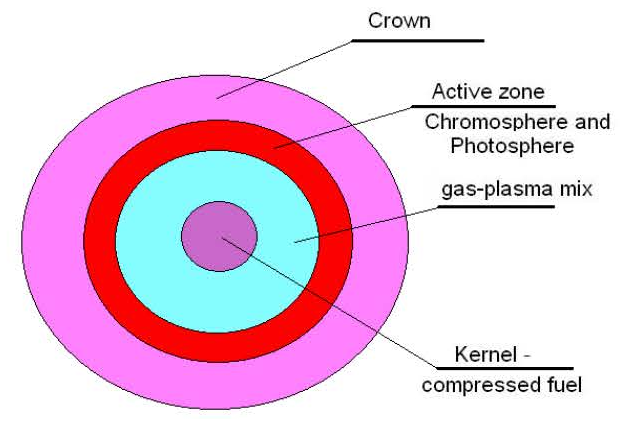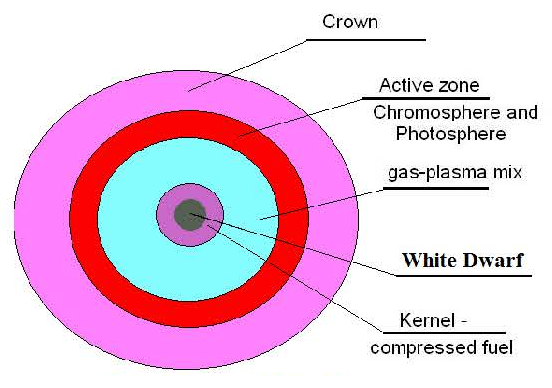After the dump of pressure and decrease in quantity of the spots, the temperature is raised in greater volume and the following break should result even more spots. It is possible to predict by the cycles of the spots the change of temperatures and pressure in the Sun. The greatest last break in the active zone should occur in the warming up process over the thickness of almost all gas-plasma mix (or on its greater part) so there is maximal break and the greatest dump of gas and plasma. Since there was a maximal dump heated over all the thickness of the gas-plasma mix, the cycle should return on a lower level. Whether should, the dynamics of spots occurrence change with the years? Certainly, should. In fact, its many parameters varywith the years: the size of the white dwarf; the weight of the star; the weight and volume of the gas-plasma mix and so on.The influence on the dynamics of dark stains occurrence on the surfaces is rendered as well by the nuclear explosions occurring in the star. Hence, the occurrence of dark stains on the star surface is also influenced by the nuclear processes occurring inside of it.
The number of spots and frequency of cycles should probably increase with the years. In case of increase in both these parameters, the increase in the frequency of cycles can be unnoticeable because of the increase in the number of spots will close the changes in frequency of cycles.
As the maximal number of spots will be displaced in time and there will be a change in time of frequency, we shall receive a new maximum of spots, but on other crest already, which was displaced on frequency, and has graphically remained on the old place. This is our forecast. But let’s consider the schedule of quantity change in the dark spots during the period of the year 1800 and up to now, fig. №R-4.7.

(58) Figure №R-4.7
Apparently from figure №R-4.7, our forecast was justified, so further explanations is unnecessary.
In figure №R-4.7 three schedules are represented: «A», «B» and «C». On the schedule «A» activity cycles of the Sun from 1800 to 1900 are represented, on the schedule «B» activity cycles of the Sun from 1900 to 1990 are represented. On the schedule «C», schedules «A» and «B» are combined. Overlapping of schedules was done on the first cycles in centuries. Apparently from the schedule «C», the displacement of cycles predicted by us and the increase in activity values, are proven to be true. But there is still an interesting feature. This is a surprising similarity of the first five cycles, which speaks in favor of the similarity of physical processes occurring inside of a star. Thisconfirmsourforecasts.
— A kernel of a star
In the beginning of a star life, the kernel probably represents the weight of the compressed fuel. This weight, under the action of high pressure, is in the compressed state. The state of the matter of the kernel of stars, (gaseous, liquid, firm, or liquid and firm in same time), is probably depends on the sizes of stars (figure №R-4.8).
The fuel in the kernel is in packed state under the pressure action.
As a result of a thermonuclear synthesis of easy kernels, fuel of the gas-plasma mix is being spent (decreases). Part of the gas-plasma mix is thrown out in space in the form of radiation, giving to a star the impulse for compression of the gas-plasma mix and pressure maintenance in the star. Other part of the gas-plasma mix is being compressed, forming heavier and packed kernels, and moves to the center of star, to its kernel.
(59) Figure №R-4.8
In the active zone which is being on the top layers of the star atmosphere, thermonuclear synthesis of hydrogen and easy kernels occurs. It is possible to assume with a high probability, that in most of the star volume, a synthesis of kernels of atoms is possible, but where and under what conditions, we do not know precisely. Most of the energy is allocated in «the active zone» which is located on the top layers of the star atmosphere, and surrounds it from different directions. Even if the synthesis of easy kernels begins in the bowels of stars under the action of Archimedes force, the heated plasma sphere, where a thermonuclear synthesis occurs, should rise in the top layers of the star atmosphere.
In the gas-plasma mix on the surface of the white dwarf, and probably inside of him, there are nuclear reactions of the synthesis, part of which occurs with absorption energy and weight. The variants of nuclear reactions of division and disintegration, as well as synthesis of kernels in the compressed fuel on the kernel surface of a star («the white dwarf») aren’t excluded.
The particles receiving kinetic energy in «the active zone», constrain the expansion of the gas-plasma mix and create superfluous dynamic pressure in the star nutria, that probably, leads to synthesis of heavier kernels in its bowels. Heavy atoms, molecules, particles, fall due to the gravity to the kernel and gather in its center, superseding from the kernel easy atoms (atoms of «fuel») (figure №R-4.9).
(60) Рисунок №R-4.9
Near «the active zone» and possibly in other centers of energy allocation inside of the star, there is a physical unpacking of substance of the gas-plasma mix, under the action of heats.



